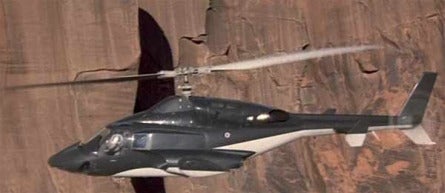Published August 26, 2010 05:53PM
Airwolf and the Grand Canyon
Do tourist-packed helicopters have a place in the Big Ditch's soundscape?

Rewind yourself to the mid 1980’s, and I’ll spin you a yarn about a little show called Airwolf. For the uninitiated, Airwolf was about as killer of a weekly action show as you can imagine (Yes, better even than the Hoff as Michael Knight in “Knight Rider”).
Here’s the basic premise: Some bad guys do some bad stuff, and the Airwolf team deploys from a militarized crater somewhere; then, through unlikely physics and a good dose of luck, manages to outrun fighter jets, missiles, and the bad guys’ comically maligned efforts to hit the chopper with surface-to-surface artillery. Airwolf always wins. Never forget that.
But today, Airwolf maybe not. The National Parks Conservation Association, a non-profit, non-governmental advocacy organization, just released its report for the Grand Canyon detailing the myriad things that must (or must not) occur for the Canyon to retain it’s unspoiled natural beauty and soundscape. High up on this 80-page starry-eyed wishlist: limiting air traffic.
Since the advent of air tourism in the Grand Canyon in the 1920’s, helicopter flights over the Grand Canyon have ballooned to 50,000 per year by 1987 and stayed there, according to the report. High above the Canyon on a helicopter tour, it must be nice: Sightlines unimpeded by bends or buttresses sweeping out over the red-brown layered rock of the northern Arizona desert. No, just clear, long vistas of this mottled gash in the earth.
To backcountry users who climb, claw, and routefind their way out of the frontcountry perimeter, the sound of helicopters can ruin the wilderness experience. Just last month we received a reader letter passionately decrying the same issue.
Backcountry users reflect the tiniest slice of the Grand Canyon’s 4.5-million-person annual visitation (For the record, I have no idea what percentage of Big Ditch visitors take helicopter flights). Luckily, this isn’t a numbers game, it’s a rules game.
In 1987, lawmakers enacted the National Parks Overflight Act in an attempt to preserve what they called the park’s natural soundscape. Problem is, they didn’t. By the 1990’s, the National Parks Service was trying to quantify the soundscape problem again. In one survey, they found that 91 percent of park visitors visit parks for the quiet—second only to respondents who visit for the scenery (93 percent).
So what’s a park administrator to do? Study the problem, of course. But there is a goal: “50 percent or more of the Grand Canyon will achieve natural quiet (i.e., no audible aircraft) between 75 and 100 percent of the day (defined as a period of time between 7 a.m. and 7 p.m.)” Sounds like one of those “I’m right about 75 percent of stuff, 60 percent of the time” things, right?
Still, the goal seems good (for backpackers), but I suspect the interests of trail-phobic tourists and the small-business air companies who cater to them will probably win out. And that means the Canyon will provide the ambient, rotor-wash background on Grand Canyon hikes. On the bright side, I guess we’re just a few synthesizer lessons away from re-creating the baddest-ass television theme song ever.
Airwolf flies again.
–Casey Lyons